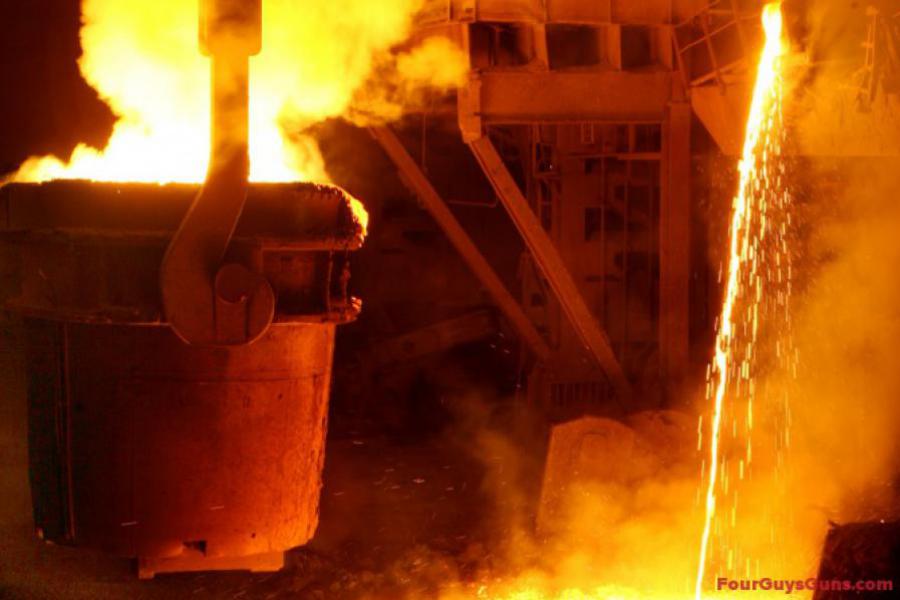Today, all we are going to do is explain some of the basics so when you see it in the Ad print, you can understand and appreciate the differences and how they affect things like cost, lifespan, wear and tear and modification. I won’t be actually recommending any one over the other, merely explaining the differences. You are going to have to do a little bit of homework on your own depending on what firearm and purpose of use for that firearm. We are just de-mystifying for those that have no idea.
Forging
Forging is one of the oldest forms of metalworking. Forging produces very strong dense packed molecular structures that can take a pounding. Knights and Samurai had their steel repeatedly hammered and heated and hammered and cooled to get the steel as dense as possible to withstand beatings. More modern forging methods are not exactly equivalent to the old samurai blacksmith, but have a similar effect. Metal gets beat and pulverized into a specified shape before moving on to its next stage of development. Forging usually does not have great detail to it, but makes up for it in brute strength.
Casting
Casting is not exactly a new kid on the block either, making molds of stuff is nothing new. That is what casting is in a nutshell really. Liquid hot metal gets poured into a “cast” or mold make of usually a sand mixture that holds the shape of a predetermined form. This allows for many molds to be produced quickly while maintaining a higher level of detail than any of the other metal forming methods. While casting is not as strong as forging, it is still a reliable method for metalworking for many industries that may be considered far more damaging than firearms.
Stamping
Stamping is a very popular way to get an exact replicant shape from sheet metal very quickly and easily. Combine the striking factor of Forging, with the mold factor of Casting and use sheet metal instead of solid metal or liquid metal and you have stamping. Stamping is usually reserved for things like car parts, pots and pans or AK-47 receivers. Sheet metal lays down on a half mold, big ass stamping tool slams down on sheet metal with other half of mold and PRESTO! You have a stamped part. Edges are removed and cleaned up and you can very quickly make hundreds of parts out of one large piece of sheet metal. Not so hard to understand why there are billions of AK’s out there no huh?
Milling/Machining
Milling is a newer form of metalworking (by comparison to the others) and was generally developed to be able to work with materials like aluminum which can be cast, but not forged. Milling is a technique that uses, bits and machinery on VERY precise plots and paths to execute an exact shape, cut, angle, depth… you name it. You take a solid block of metal (aluminum, alloy, steel, whatever) and you have either a machinist or a program execute a precise measured cutout using a spinning bit from a high torque machine to the exact specification. Think grandpa whittling, cutting away excess to reveal the desired shape…but with 1 million times more precision. Milling leads to very light, very sturdy parts that are unmatched in precision fitting (aside from good ol’ fashioned hand made) on a production line. A gunsmith hand fitting parts is the only thing I can think of that produces tighter tolerances and fit, but you pay through the nose for that.
There are many ways we can achieve desired shapes and functions from our weapons, and believe it or not, your gun probably has multiple or all of the above types or metal in it somewhere. Knowing more will hopefully aid you in the future when looking and understanding which tool for which job.
Hope this helps you in your next gun purchase or modification, remember to stay safe and always check your chambers.
Cited sources:
- http://en.wikipedia.org/wiki/Casting_(metalworking)
- http://en.wikipedia.org/wiki/Forging
- http://en.wikipedia.org/wiki/Stamping_(metalworking)
- http://en.wikipedia.org/wiki/Milling_machine
- http://blog.cleveland.com/business/2008/05/steel1.jpg
- http://www.mdzmakina.com/mdz/uploads/machining2.jpg
- http://karlzipser.com/uploaded_images/DSCF1446-745840.JPG
- http://th08.deviantart.net/fs71/PRE/f/2011/125/c/3/barrel_forging_2009_by_irishmage-d3fo0ud.jpg
- http://cheaperthandirt.com/blog/wp-content/uploads/2010/12/StampedVsMilled.jpg



